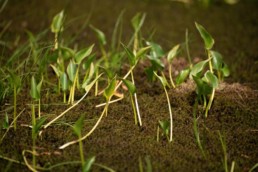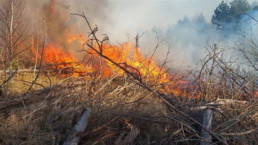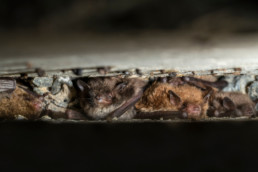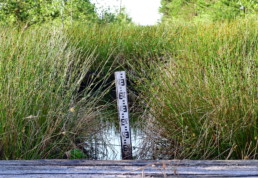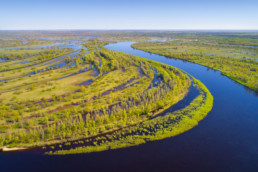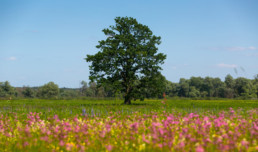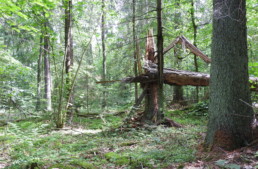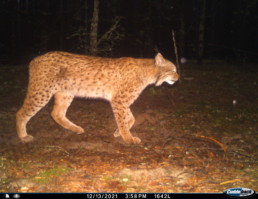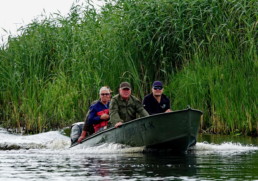River flow affects high-energy Great Snipe lekking
New study shows link between seasonal floods and Great Snipe lekking condition. The long-term research conducted at Turov Meadows in Belarus found that river water level impacts the ability of the birds to meet the high energy demands of their breeding competition. A finding that reinforces the need to maintain natural river flow in Polesia.
Each spring Great Snipes congregate in Eastern Europe’s wetlands. Rich in floodplains and marshes, Polesia offers key habitat for the waders. The birds are now listed as ‘near threatened’ with populations still in decline. A central cause of this decline is the loss of suitable habitat for breeding and nesting.
Earthworms make up 90% of the diet of Great Snipes. The location and accessibility of the worms impacts the waders’ ability to meet their resource requirements. Earthworms migrate between different soil depths depending on soil moisture. Waders rely on a rise in the water table which leaves only a narrow unflooded soil layer, forcing earthworms to congregate near the surface. Here, the birds can easily probe the softened soil with their curved beaks to extract the worms.
A good supply of food is of particular importance during the breeding season. Selection in Great Snipes takes place through lekking – a competitive behaviour exhibited by males in order to attract a mate. About 10 to 20 male Great Snipes gather in a lek where they elongate their bodies, inflate their chests, perform special songs, and flutter their wings. From time to time sparring between the males occurs.
Females choose a suitable mate based on physical attributes, but also the vigour and stamina exhibited during their lek performances. In general males with better body condition can expend more energy on lekking, winning greater attention from the females. But success in this competition demands great strain: during the mating season male Great Snipes spend four times more energy than usual. They lose about 5% of their body weight in just one night of active lekking. To regain strength and maintain good body condition during this period they must feed intensively.
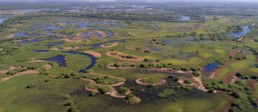
A long-term study (2001-2020) at Polesia’s Turov Meadows measured Great Snipe body size and condition and compared this data to fluctuations in the water level in the Pripyat River over time. As snow melt fills the Pripyat in spring, the water table across the floodplain rises pushing the earthworms closer to the soil surface.
At a water level in the river of 220 to 420 centimetres the body weight of male Great Snipes remained relatively stable. The layer of un-flooded soil in these conditions remains deep; the availability of prey does not change significantly. But as the water rises from 420 to 490 cm an increase in the weight of Great Snipes was observed. When the water level reaches this range, not only is the top layer of soil rich in earthworms, but also the flood loosened soil makes it easier for snipes to search for food. In such conditions, birds do not have to fly far from the breeding areas in search of feeding grounds, thus saving energy.
After the water level in the river exceeds 490 centimetres, the body weight of male Great Snipes began to decline. Under these conditions large areas become flooded, causing the earthworms to leave. The relatively short length of the Great Snipes’ legs does not allow them to feed successfully on flooded sites. The birds have to fly further in search of higher ground. Such flights and growing competition in a limited suitable habitat increases energy needs, and body condition of Great Snipes deteriorates.
Water level can therefore indirectly impact the condition of lekking Great Snipe males.
The study suggest that hydrological management of grasslands in river valleys is especially important not only for Great Snipes, but possibly also for other earthworm-feeding species. Rivers should be left unaltered to allow natural spring floods to occur. Unfortunately, only 37% of all the world’s major rivers remain free-flowing, with dams, reservoirs, water extraction, and sedimentation disrupting the natural flow of the rest. These interventions, along with the conversion of floodplain wet meadows into intensively used agricultural land with excessive fertilisation and drainage ditches created to lower the level of groundwater, are the main reasons driving the loss of suitable breeding habitat for waders.


